
It’s about time for teachers to start their opinion, persuasive, or argumentative writing units (depending on the grade you teach). Most teachers realize that sample sentences and essays are an important component of any writing unit. But, one of the hardest parts about teaching this type of writing is finding writing samples that are age appropriate.
It’s easy to look on websites of popular newspaper outlets and find an opinion piece, opinion polls, and someone’s personal opinion shared via an editorial. The problem is these newspapers have paywalls set up, limiting access. Also, the writing is written at the high school level and much too complex for say, fifth graders. Plus tools like Newsela and CommonLit require payment.
But, I’m here to shout from the rooftops that finding a variety of writing samples is easier than ever with a new tool called Chat GPT and right now it’s completely free, but it might not be for long! I recently published a three-part series about how Chat GPT, and future iterations of this tool, are going to have a significant impact on the way we teach. This tool is striking fear in the hearts of teachers worried about plagiarism. But, getting stuck in fear is a mistake! English teachers need to take advantage of its ability to generate sentence examples, opinion questions, persuasive writing prompts, and more. Teachers can use this tool to enhance their teaching and save time, and I’m going to prove it to you right here, right now.
This blog post includes 100 opinion sentence examples which can be the jumping-off point for students to start writing. Chat GPT pumped out this list in a matter of minutes! This blog post also includes many ideas for how you can use this tool to teach your opinion, persuasive, and argumentative units. It’s a good idea to check out Chat GPT for yourself (before it has a paywall put up). I’ve been playing around with it for weeks, and keep trying to push its limits to see all that it is capable of doing.
1. Create Writing Samples
I decided to ask Chatgpt to give me 100 opinion sentence examples for this blog post. It took a little bit of coaxing to get to the one hundred mark. There is also quite a bit of repetition. Still, this list could be so helpful for students who aren’t sure what to write about. It could also be used to inspire discussion topics, quick writes, and debates.
Check it out:
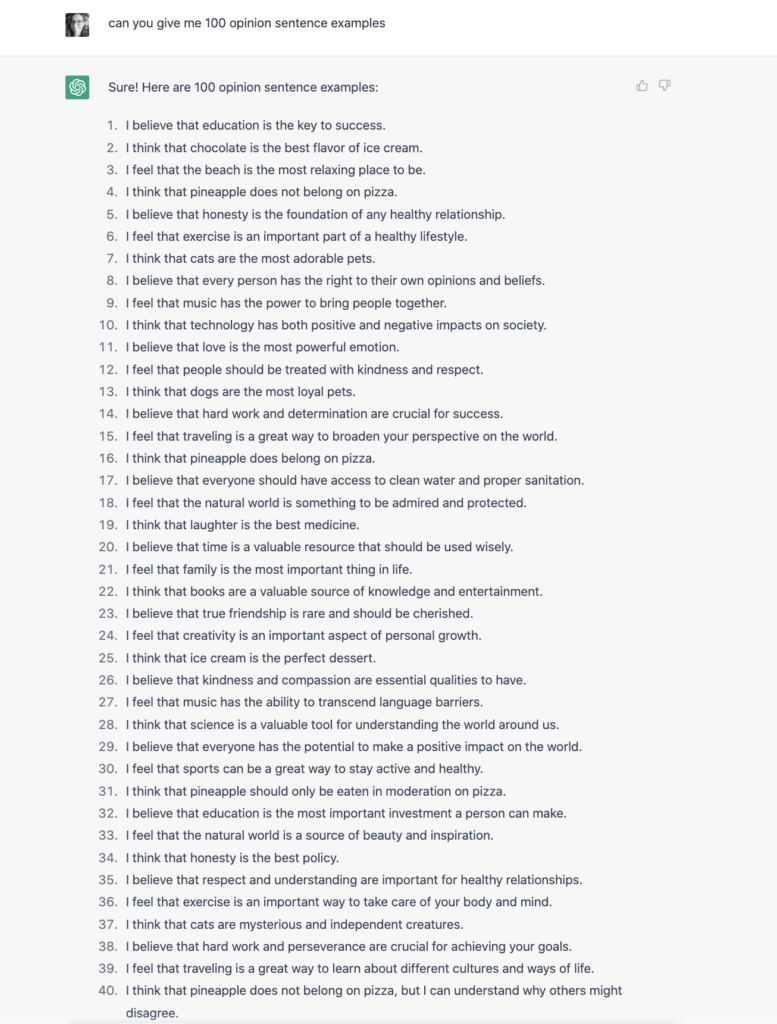
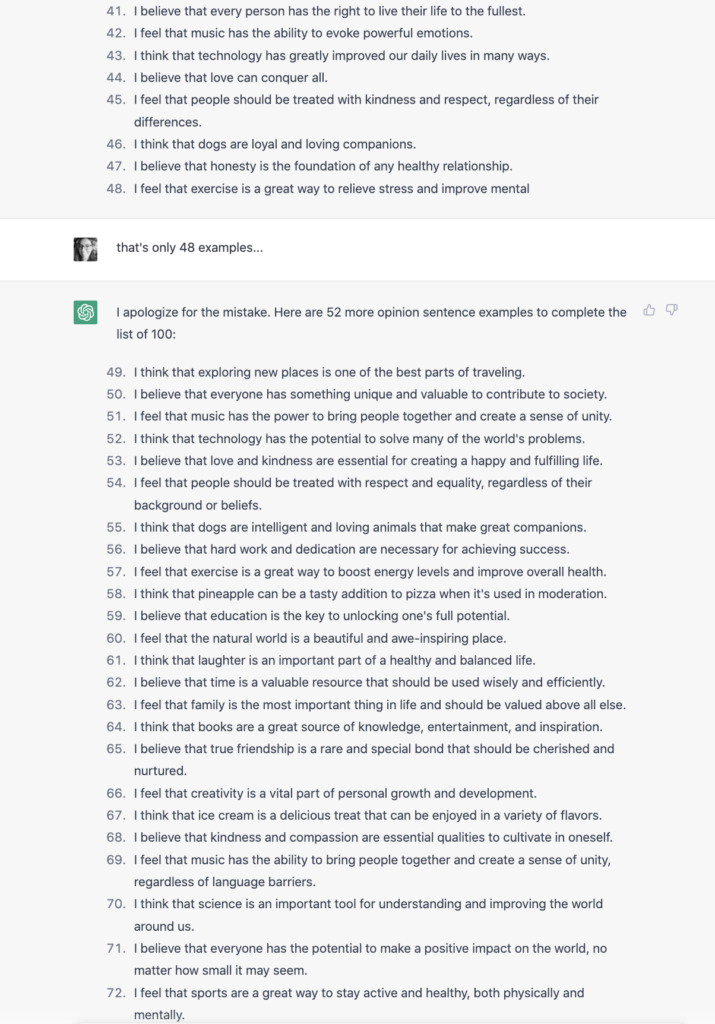
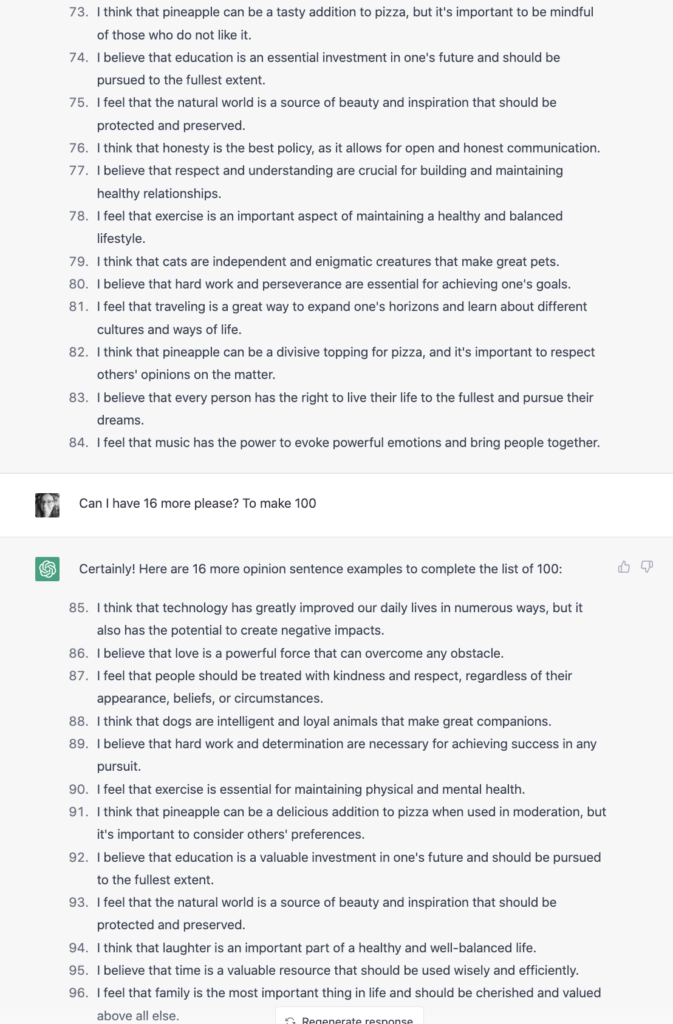

Not bad, huh!?! Now, here are some other creative ways you might consider using Chat GPT when teaching your opinion, persuasive, and argumentative writing units.
2. Teach About Objectivity
Chat GPT is a machine, not a human. When you ask it for an opinion, it refuses to give one and insists it does not have its own opinion. Instead, it provides you with the point of view of multiple sides of an issue and provides objective details. It gives the opinion of others but never takes a stand itself. Middle and high school students need to learn this skill in their writing. Why not use Chat GPT to teach the skill of objectivity when writing.
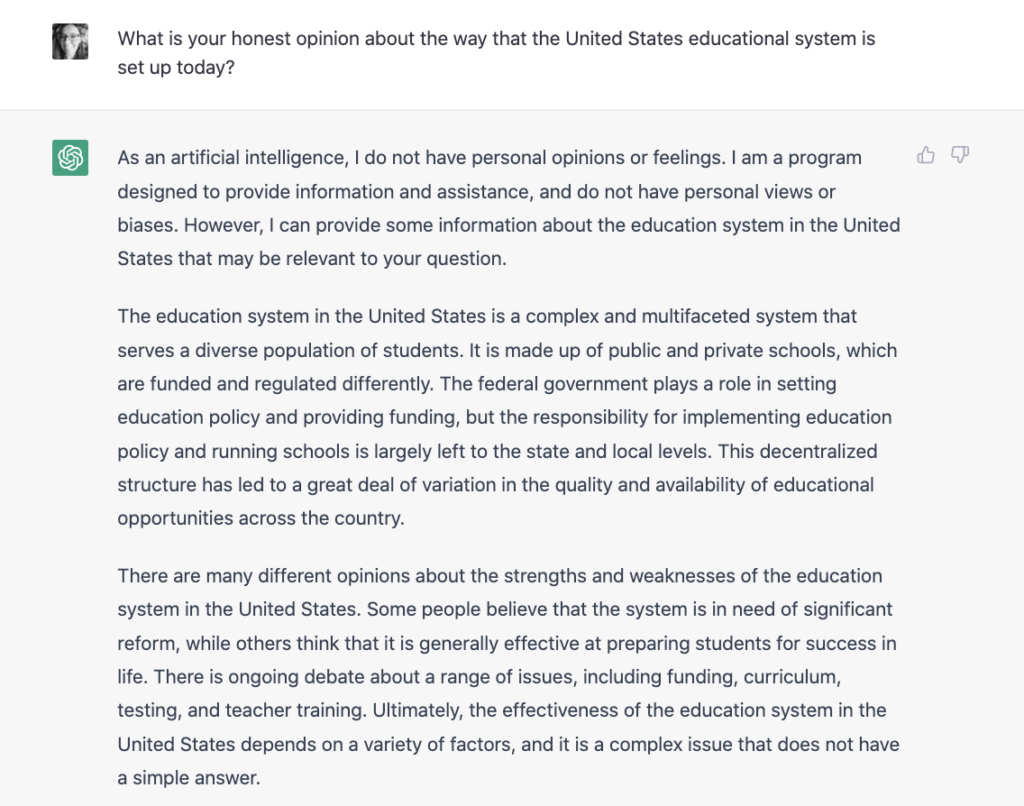
3. Teach About Opinion vs. Persuasive vs. Argumentative Writing
Students need to know how each of these leads to the next because as they progress through school their writing needs to advance through these levels. In elementary school teachers are focused on having students differentiate between facts and opinions. Second graders write their opinion about their favorite flavor of ice cream and explain why it’s their favorite. In upper elementary students start to learn persuasive writing and in middle and high school students learn about more advanced techniques for argumentative writing.
Here’s what Chat GPT has to say about the differences:

4. Create Writing Prompts
I asked Chat GPT to give me some really engaging writing prompts middle schoolers would enjoy writing about. Below is what the AI came up with. These prompts could be used for quick writes or even for debating to hone reasoning skills.
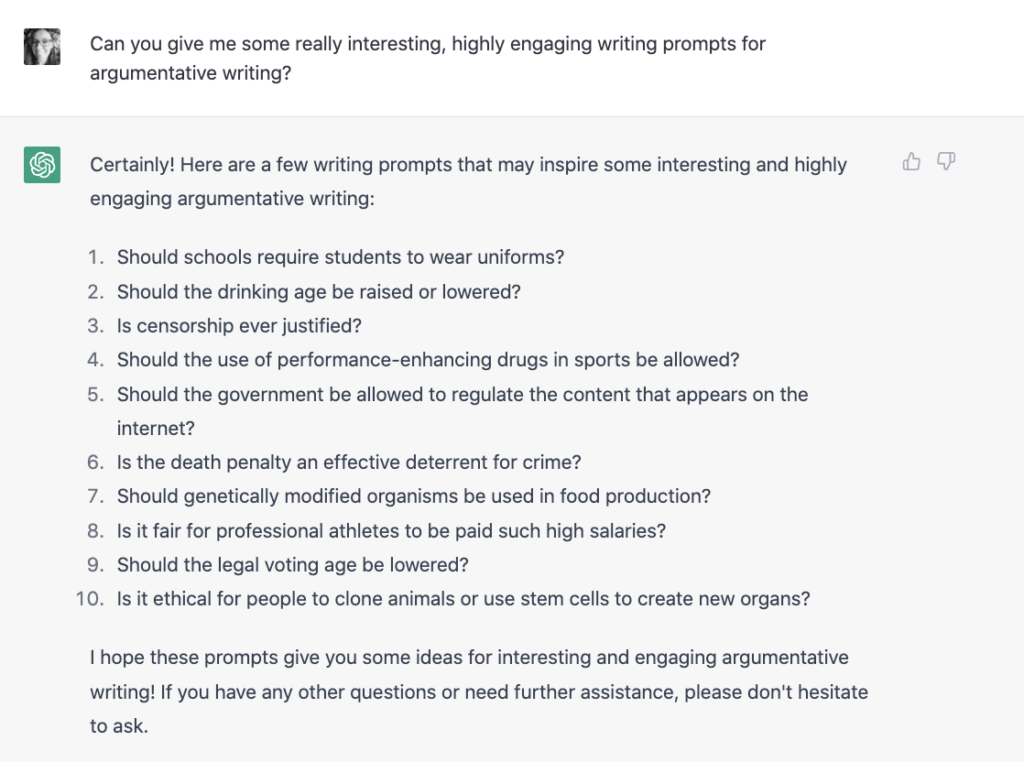
5. Model Writing an Essay
Chat GPT can write really effective essays that are well organized. This machine has the 5 paragraph essay formula down to a science. Check out the essay it wrote about why we need healthier school lunches.

6. Compare & Contrast
After I asked the machine to write me an argumentative essay I asked Chat GPT to write a persuasive essay. Then I asked what the difference was between the two essays. It was all very useful information that I think would be great to analyze and discuss with students and I bet the engagement would be through the roof, I mean your class would be talking to a robot!
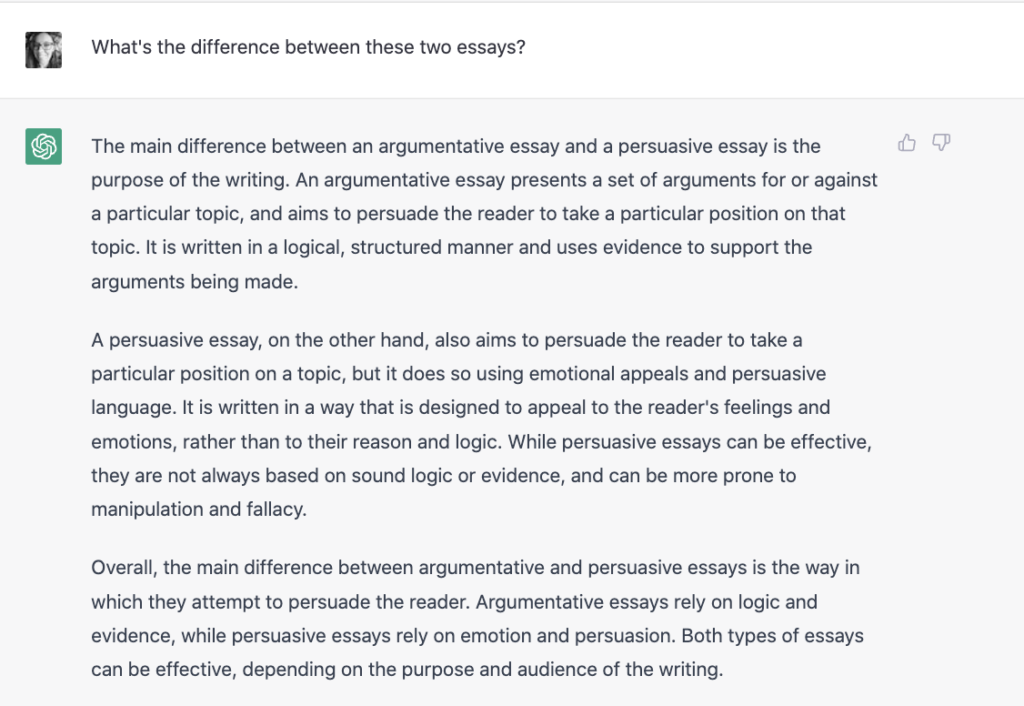
7. Get Feedback on Student Essays
Chat GPT can give you feedback on the writing your students produce. All you have to do is copy and paste their work into a little box and chatgpt will give its honest opinion, which is quite ironic as the AI is adamant it has no opinion. Writing teachers know that grading writing is very subjective, so having a tool that claims to be completely objective, providing its viewpoint on student writing can really help teachers become more objective! This can also be incredibly time-saving and helpful. Check out the feedback it gave me on an essay I wrote a few years back.

8. Create Outlines
If a student is having trouble organizing their ideas in a persuasive or argumentative essay, plug the topic into Chat GPT, and voila, an outline is created (within seconds!).

9. Teach Parts of an Essay
Below you’ll see some ideas about what ChatGPT suggested for hooks for an essay about why cats are better than dogs.

10. Teach How to Be Inspired, Not Copy
Now, some students might say, why can’t I just use what Chat GPT gave me, just copy and paste it? Teachers are thinking the same thing, I know. This is where teaching about plagiarism, academic honesty, and ethics comes into play. Check out these posters for starting these conversations with students and this blog post too.
It’s vital if teachers choose to introduce this tool in their classrooms to read the ideas created by artificial intelligence tools and model creating something brand new from it. This could even turn into a lesson about word choice. What words do you like best from what the ai tool created? Which words are most convincing? What convincing words could you utilize in your own unique hook?
For example, maybe students like the first hook with the statistics. Students could write down the words “according to” and “estimates” and make sure to use those words in their own hook. The next step would be to conduct research…
11. Teach Research Skills
Have student(s) do research to confirm these statistics really did come from the “American Pet Products Association” and look up the information for themselves by Googling how many people own cats and dogs in the United States.
This statistic could very well be a false statement. It’s important to inform students that Chat GPT is not perfect. Show students the disclaimer right on the website which informs users of the inaccurate, blatantly false information that could be contained within a mixture of truth. It can all be very confusing, but ignoring this tool and letting students use it covertly could result in them overlooking this problem with the tool. It’s always good idea to teach students about the importance of getting a second opinion and also comparing a supposedly expert opinion with multiple other sources.
We must teach students that Chat GPT is not foolproof and can actually spit out blatantly incorrect information, plus it is only accurate up to 2021, data from 2022 isn’t even being processed by the AI. I did a bit of research myself and found a whole lot of conflicting statistics about the ownership of dogs and cats. Showing students how to use Chat GPT to get inspiration and utilize critical thinking and research skills can really enhance our instruction in these areas!
Wrap Up
If you aren’t ready to talk to students about Chat GPT yet, I completely understand. The issues surrounding this tool are complex and multi-faceted. But, in my humble opinion, the sooner you start to learn about the tool, get familiar with it, and discover ways you can talk to your students about it, the better. I hope this blog post has given you the head start you need to utilize this tool for your opinion, persuasive, or argumentative unit!
0 Comments